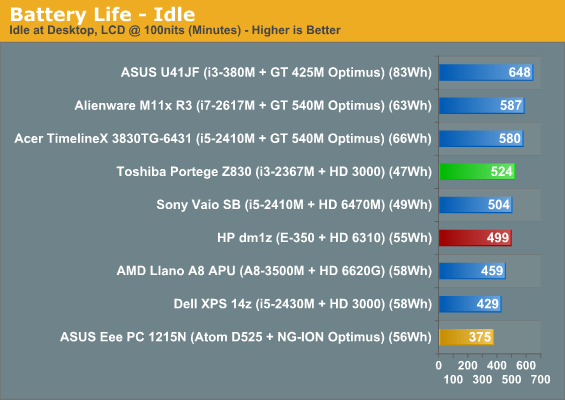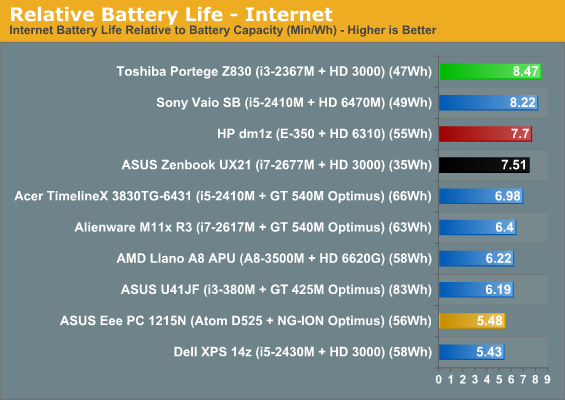Toshiba Portege Z835: A New Ultrabook Appears
by Dustin Sklavos on November 16, 2011 2:50 AM EST- Posted in
- Laptops
- Intel
- Toshiba
- Sandy Bridge
- Ultrabook
Battery Life, Heat, and Noise
Despite the incessant griping about the pokey Intel Core i3-2367M beating at the heart of the Toshiba Portege Z830, there's one place where a low-powered processor can pay dividends: battery life. The Z830 may have a weaker processor than the competing ASUS Zenbook UX21, but it also has a bigger battery. Check out this running time.






For sheer running time, the Portege Z830 lives up to the promise of ultrabooks, being an incredibly mobile notebook that lasts for a long time off the mains. When you look at the relative battery life, things get even better, with even the Optimus-enabled ASUS Eee PC and HP's E-350-based dm1z putting in weaker showings. Intel's CULV chips have historically been big winners, and suddenly the i3-2367M doesn't look so bad anymore: it's faster in every way than Atom or Zacate, and more frugal with power to boot. That said, the Z830 also benefits from having an mSATA SSD which is also going to sip power.

All that battery life wouldn't amount to much if the Z830 was noisy or hot in the process, but surprisingly it's neither of those things. The fan has a very low whine when the system is idling that isn't particularly intrusive, and while that whine does increase in volume under load, it's still nowhere near as irritating as the fan noise is on most notebooks. Better still, despite the thin, flimsy chassis, the Z830 remains fairly cool to the touch as well. During our stress testing loop, no hot spots really surfaced: this is a very cool, very quiet notebook that's definitely fine for using as an honest to goodness laptop.










76 Comments
View All Comments
inighthawki - Wednesday, November 16, 2011 - link
Depends on the kind of work. I do a lot of programming, and as a result, tiling two coding windows side by side in visual studio works wonderfully on a widescreen display, but not so much on a full screen display.uhuznaa - Wednesday, November 16, 2011 - link
I would really like to see some statistics how old people are who buy such things and how their eyesight is. 1600x900 on 13.3" with no way to adjust the OS to it means that everything you want to read and click on the screen becomes that small that working with it for many hours a day becomes a strain. Yeah, you can cram more content and toolbars and icons onto the screen, but this comes with a price.I know more than enough "normal" users who think that such many pixels are even too much to be comfortable on 19" desktop displays and run them with non-native resolutions just to get comfortable UI sizes. Especially since they just have no need for 1600 horizontal pixels since they run everything full-screen anyway.
retrospooty - Wednesday, November 16, 2011 - link
"1600x900 on 13.3" with no way to adjust the OS to it means that everything you want to read and click on the screen becomes that small"Win7 click start>control panel>display and set it from 100 to 125 or even 150% if you are really blind.
SoundsGood - Wednesday, November 16, 2011 - link
>> Win7 click start>control panel>display and set it from 100 to 125 or even 150% if you are really blind.That's fine if you *only* use the laptop's screen. But not so great for those of us that often use an external monitor. It means always switching back and forth between 125 DPI and 100 DPI... which is NOT fun.
Filiprino - Wednesday, November 16, 2011 - link
It's a non-issue. Sony has the Vaio Z with 1080p on it's 13 inch screen. That's a real problem.But 1600x900 on 13 inches it's not a problem. I've got a 15,6 inch laptop with full hd screen and it's really nice. Not only because you can have more things being displayed, but also for things that were traditionally huge now they aren't.
And of course, more resolution benefits productivity.
peterfares - Wednesday, November 16, 2011 - link
Sony's screen is wonderful. I used the Vaio Z with a 1080p screen at the Microsoft store. The DPI was set to 150% so everything appeared the normal size for a 13" computer, but everything was SO CLEAR. It was awesome. I really want one, but they're very expensive!MrSpadge - Wednesday, November 16, 2011 - link
For me 1366x768 is borderline uncomfortable on 11.6". So I guess I wouldn't want more than 1400x900 at 13.3".MrS
peterfares - Wednesday, November 16, 2011 - link
You can increase the DPI setting which makes everything bigger but sharper than a standard resolution display.peterfares - Wednesday, November 16, 2011 - link
Windows 7 has great scaling capabilities. The whole OS has higher resolution graphics for when you increase the DPI setting. Third party support is not quite there yet, but things just get blown up to make them bigger. Not that annoying when the DPI is high enough.piroroadkill - Wednesday, November 16, 2011 - link
I'm going to go further than this: They need to offer it in 16:10, not 16:9 as you suggest is OK.How about 1680x1050, laptop makers :3
Look at the retarded huge bezel below and above the screen. This is getting out of hand. 16:9 is a terrible ratio for computing, but because the screens are getting spat out cheaply, this is what we get.